
PREV ARTICLE
NEXT ARTICLE
FULL ISSUE
PREV FULL ISSUE
MORE SMALL COINSIndian Gold Fanams
Talking of small coins, the smallest in my collection is the 5.8 mm Indian gold Fanam. Unlike the other Indian gold fanams with geometric designs the detail on this tiny elephant coin is amazing for its size. 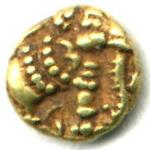 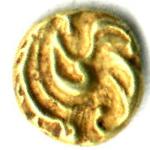 To read the complete article, see:
Medieval Russian Coins
Eric Schena submitted these notes and images on some tiny medieval Russian coins. -Editor
I saw the E-Sylum entry about tiny coins and most notably the mention of the tiny silver coins from medieval Russia. Before I was seduced by the joys of exonumia I specialized in early Russian coins and built up a decent collection of the things which I still have. Some of the feudal era coins prior to Ivan the Great and Ivan the Terrible were amazingly small and included not only the more familiar denga (half kopeck) but also half denga (polushka) and quarter denga (chetveretsa) that are positively microscopic. Here is a small selection of medieval Russian coins compared to a three-cent silver piece for comparison's sake. From left to right, the coins are: Principality of Novgorod
AR Chetveretsa; no date (c. 1420-1478); no mint name; 0.10 g.; 6.8 x 9.2 mm; Gaidukov 106, Oreshnikov 51 (pl. I, 12), Spassky fig. 66-7 This is the smallest coin in my entire collection and is paper thin. Principality of Tver
AR Kopeck; no date (1547-1584); Novgorod; 0.62 g.; 16.0 x 12.3 mm; Melnikova 22-26, KG 80 This coin is dramatically double struck with two clear strikes; ex: Montgomery Blair. Montgomery Blair was Lincoln's Postmaster General and he had a small group of these, almost all of which were from Ivan IV's reign. I got a few of these pieces from Gene Brandenburg when I worked for him back in the day... AR Denga; no date (1547); Tver; 0.35 g.; 9.2 x 12.0 mm; Melnikova 18-22, KG 72 AR Polushka; no date (1535-1584); Moscow; 0.15 g.; 8.9 x 7.6 mm; Gaidukov 372/384, KG 98, Spassky 79-9 Peter I "the Great" as sole Tsar
Some day I would love to put that Novgorod chetveretsa on a Swedish copper plate 8 daler piece. Thanks! Remember, to see larger images of E-Sylum photos, click on them to go to our Flickr archive. -Editor
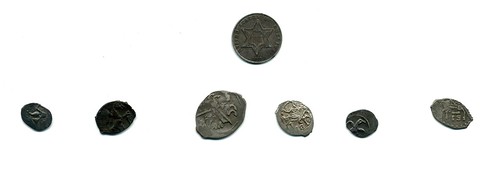 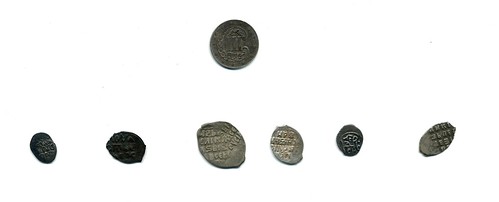 Thai Bullet Coins
Ken Spindler of San Diego submitted these notes on exceptionally small world coins. Thanks. -Editor
 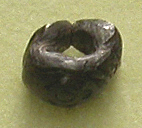  In addition to owning the large uncut sheets of French assignats I wrote about last week, I also own numerous exceptionally small world coins from the last few centuries. In 2005 I showed a few dozen of them in an exhibit, and a local artist created an art book using my graphics and text. The lightest coin I had weighed .04 grams. It was (and still is) a very thin uniface gold Nepal dam from 1847-81. It isn't perfectly round. The maximum diameter is 6.94 mm. But diameter-wise, that coin dwarfed a possible Thai silver "bullet" coin I owned for half of 2007. It's a sad & embarrassing but funny tale. Kent Ponterio photographed the coin for me, to show Scott Semans, who I approached to learn what I could about it. Its previous owner catalogued it as a 1/128 baht. It bore a crude chakra. I measured it as about 2-3 mm. diameter, and it weighed just under .05 grams. Scott concluded that it was probably a piece made by an "upcountry" Thai hill tribe, not an official national issue. He pointed out that a 1/128 baht should have weighed .12 grams. Both Charles Opitz's An Ethnographic Study of Traditional Money and the Standard Catalog of World Coins listing are entirely consistent with all of this. The sad & embarrassing part? I spent New Year's Eve 2007-8 working up coins which had accumulated on my desk during the past year. I had the Thai piece out of its 2x2, laying on the clean towel where I lay raw coins before I package them. The last thing I did after I finished up with everything else, was to notice that there was some residual crud on the towel. (You can guess the rest.) I took the towel outside on my 2nd story patio and shook it out aggressively over the balcony, then tossed it back on my desk before hitting the sack. Next morning I realized what that dirt must have been. I spent fruitless hours searching my patio and the mulched plants in the courtyard below. Maybe it's still down there, a few inches below the surface. At least I still have the close-up photos and measurements. And I have a replacement tiny fractional baht bullet money piece in my collection now, weighing in at .19 grams, with slightly below 4 mm. max diameter. I'm NOT going to take it out of its 2x2 to measure it better or photograph it. Understand, it's anything but flat - it's closer to a tiny thick doughnut; almost a ball. 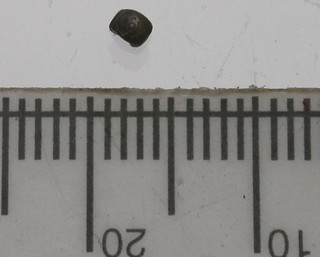 Sad tale, although I'm sure Ken wasn't the first collector to lose something to their primal urge to have things neat and
clean. -Editor
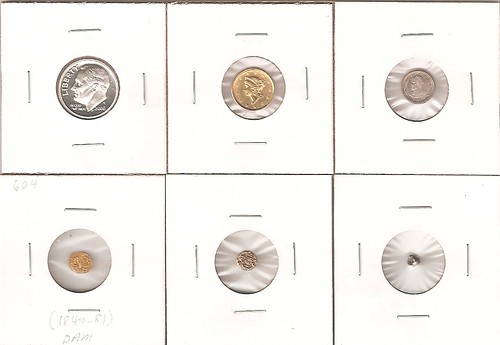 First, for comparison purposes, is a U.S. dime (17.9 mm.). Next, the smallest regular U.S. issue, being the first series Liberty Head gold dollar. At 12.7 mm. diameter, it was smaller than the smallest half dimes (15.5 mm.) and 3 cent silvers (14 mm.). Next is a 1904 Panama 2-1/2 centavo "pill," which Mr. Johnson cited (10.23 mm.). Next is my thin uniface gold Nepal dam (6.94 mm., .04 gram). Next is a gold fanam (=1/2 anna, ordinarily a copper coin) from Mysore State, India, 1799-1810, 5.94 mm. It depicts a facing man-lion incarnation of the Hindu god Vishnu. Can you see that? Finally, my replacement smallest Thai bullet coin (.19 gram, but less than 4 mm.). As I learned the hard way, these are easy to lose! Minimissimi
Ron Haller-Williams submitted some great information on the "minimissimi", 5th/6th century barbarous copies of Roman
coins. Thanks! -Editor
The smallest pieces (mentioned in the item in The E-Sylum of 5th January) appear to be:
There is, however, no mention of the "minimissimi", which appear to be 5th/6th century barbarous copies of Roman coins, apparently ranging in diameter from about 5mm down to 2mm(!) Although at first thought of as actual coins, these were apparently used as votive pieces, so maybe would now be categorised under paranumismatica. For example, see p.11 of FROCESTER - A Romano-British Settlement its Antecedents and Successors Eddie Price VOLUME 2 THE FINDS
"There are 16 in the Frocester series less than 8mm in diameter, including one of 4mm, one of 2½mm, and one of 2mm (no 156)." and The Ending of Roman Britain By A.S. Esmonde-Cleary 2002 p.76: "Another site which has yielded coins which may be linked with religious observance was the great fourth-century temple-complex at Lydney [193] on the north side of the Severn estuary. There were found large numbers of tiny, bronze coins (minimissimi — fifty to cover an old halfpenny or modern twopenny piece) copying mid-fourth-century prototypes. These were far too small to be of any practical use, and their presence on a temple site may suggest that they had some token, votive use." To read the complete item, see:
* A.S. Esmonde-Cleary, The Ending of Roman Britain (2002), p.76: "Another site which has yielded coins which may be linked with religious observance was the great fourth-century temple-complex at Lydney [193] on the north side of the Severn estuary. There were found large numbers of tiny, bronze coins (minimissimi — fifty to cover an old halfpenny or modern twopenny piece) copying mid-fourth-century prototypes. These were far too small to be of any practical use, and their presence on a temple site may suggest that they had some token, votive use." * In the item on "Monim or Minimos" in "The teach yourself guide to numismatics : an A B C of coins and coin collecting" (1956-1970 - titles vary), Christopher Churchill Chamberlain says: "Some of these are no bigger than the head of a pin; in fact, more than fifty of such minimissimi (smallest minimi) would be needed to cover a modern halfpenny. In 1929 a hoard of many hundreds of these coins was found at Lydney Park, Gloucester." [IF the authors meant that the halfpenny (25.4mm) or twopence (25.9mm) had 50 times the area of such minimissimi, this would give an effective diameter of 3.6 to 3.7mm.] * Philip Kiernan, Miniature votive offerings in the north-west provinces of the Roman Empire (2009), p.163: "5.5 The 'minimissimi.' In 1929, a hoard of 1,646 bronze coins was found underneath a mosaic floor in the bath-house at Lydney Park. Some of these coins, termed minimissimi by Wheeler, had an average diameter of 2.75 mm, and an average weight of 0.057g. All were crude copies of Roman bronze coins with the legend FEL TEMP REPARATIO that were struck in the middle of the fourth century A.D. but ..." * John H. Humphrey, Journal of Roman Archaeology: Supplementary series - 1999 - Architecture, p.31: "An exception may be the substantial numbers of tiny late Roman coins (so-called minimissimi) at Lydney Park (Glos.), which were possibly the result of unofficial production for ritual purposes." Items Made With Travancore Silver Coins
I don’t know what the inhabitants of Travancore thought of their tiny silver coins but the local silversmiths liked them. They fashioned them into all sorts of items for the breakfast table and my brother Harry has many examples in his ornamental money collection. Some are made from several hundred coins. I have to assume that they were made for the British residents shortly before independence.  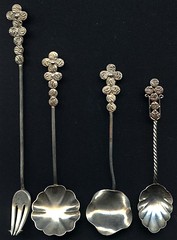
Cake stand and silverware 

Menu holder and dish 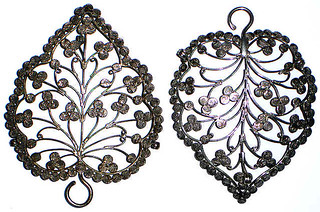
Cake stand Thanks! I've never seen these before. Great craftsmanship. -Editor
To read the earlier E-Sylum article, see:
Wayne Homren, Editor The Numismatic Bibliomania Society is a non-profit organization promoting numismatic literature. See our web site at coinbooks.org. To submit items for publication in The E-Sylum, write to the Editor at this address: whomren@gmail.com To subscribe go to: https://my.binhost.com/lists/listinfo/esylum All Rights Reserved. NBS Home Page Contact the NBS webmaster 
|